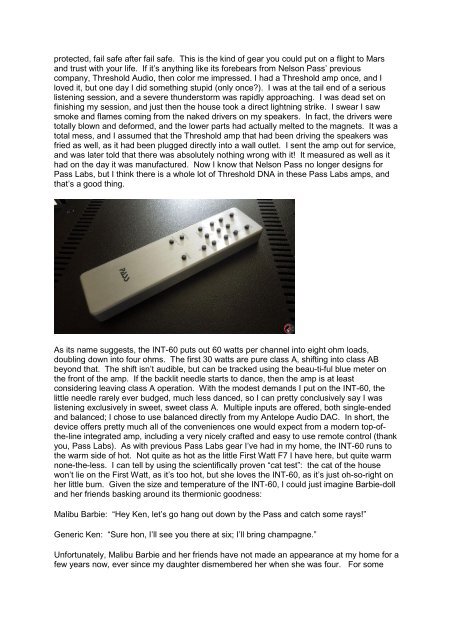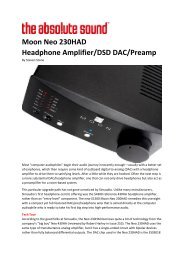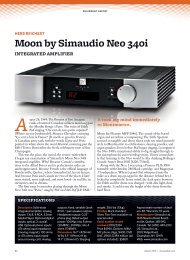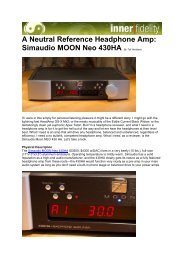Pass Labs INT-60 Integrated Amplifier review
INT-60_part-time_audiophile
INT-60_part-time_audiophile
You also want an ePaper? Increase the reach of your titles
YUMPU automatically turns print PDFs into web optimized ePapers that Google loves.
protected, fail safe after fail safe. This is the kind of gear you could put on a flight to Mars<br />
and trust with your life. If it’s anything like its forebears from Nelson <strong>Pass</strong>’ previous<br />
company, Threshold Audio, then color me impressed. I had a Threshold amp once, and I<br />
loved it, but one day I did something stupid (only once?). I was at the tail end of a serious<br />
listening session, and a severe thunderstorm was rapidly approaching. I was dead set on<br />
finishing my session, and just then the house took a direct lightning strike. I swear I saw<br />
smoke and flames coming from the naked drivers on my speakers. In fact, the drivers were<br />
totally blown and deformed, and the lower parts had actually melted to the magnets. It was a<br />
total mess, and I assumed that the Threshold amp that had been driving the speakers was<br />
fried as well, as it had been plugged directly into a wall outlet. I sent the amp out for service,<br />
and was later told that there was absolutely nothing wrong with it! It measured as well as it<br />
had on the day it was manufactured. Now I know that Nelson <strong>Pass</strong> no longer designs for<br />
<strong>Pass</strong> <strong>Labs</strong>, but I think there is a whole lot of Threshold DNA in these <strong>Pass</strong> <strong>Labs</strong> amps, and<br />
that’s a good thing.<br />
As its name suggests, the <strong>INT</strong>-<strong>60</strong> puts out <strong>60</strong> watts per channel into eight ohm loads,<br />
doubling down into four ohms. The first 30 watts are pure class A, shifting into class AB<br />
beyond that. The shift isn’t audible, but can be tracked using the beau-ti-ful blue meter on<br />
the front of the amp. If the backlit needle starts to dance, then the amp is at least<br />
considering leaving class A operation. With the modest demands I put on the <strong>INT</strong>-<strong>60</strong>, the<br />
little needle rarely ever budged, much less danced, so I can pretty conclusively say I was<br />
listening exclusively in sweet, sweet class A. Multiple inputs are offered, both single-ended<br />
and balanced; I chose to use balanced directly from my Antelope Audio DAC. In short, the<br />
device offers pretty much all of the conveniences one would expect from a modern top-ofthe-line<br />
integrated amp, including a very nicely crafted and easy to use remote control (thank<br />
you, <strong>Pass</strong> <strong>Labs</strong>). As with previous <strong>Pass</strong> <strong>Labs</strong> gear I’ve had in my home, the <strong>INT</strong>-<strong>60</strong> runs to<br />
the warm side of hot. Not quite as hot as the little First Watt F7 I have here, but quite warm<br />
none-the-less. I can tell by using the scientifically proven “cat test”: the cat of the house<br />
won’t lie on the First Watt, as it’s too hot, but she loves the <strong>INT</strong>-<strong>60</strong>, as it’s just oh-so-right on<br />
her little bum. Given the size and temperature of the <strong>INT</strong>-<strong>60</strong>, I could just imagine Barbie-doll<br />
and her friends basking around its thermionic goodness:<br />
Malibu Barbie: “Hey Ken, let’s go hang out down by the <strong>Pass</strong> and catch some rays!”<br />
Generic Ken: “Sure hon, I’ll see you there at six; I’ll bring champagne.”<br />
Unfortunately, Malibu Barbie and her friends have not made an appearance at my home for a<br />
few years now, ever since my daughter dismembered her when she was four. For some





